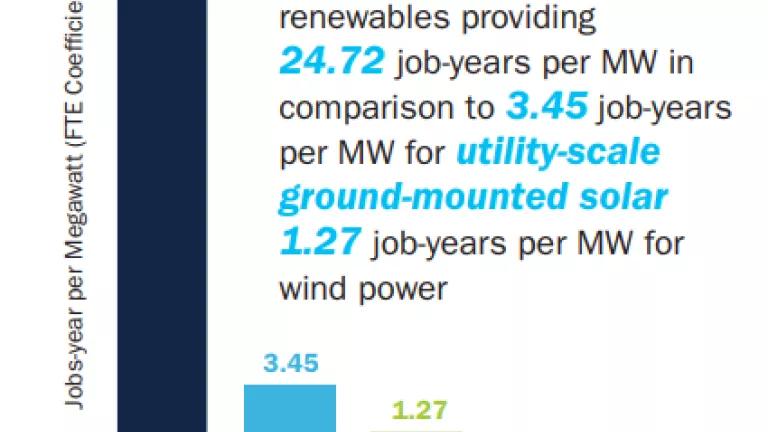Distributed Renewables and India’s Energy Transition

In India’s remarkable renewable energy growth story, the importance of distributed renewable energy often gets overlooked. Even after a year of record growth in fiscal 2019, distributed renewables, which include off-grid power and rooftop solar, are only about 5% of India’s total installed renewable energy capacity and just about 1% of the total installed electricity capacity.
As experts, including my NRDC colleagues in Delhi, gather to discuss India’s energy transition pathways at the Energy Horizons event this week, a key focus will be on why investing in distributed renewables, also known as decentralized renewable energy, is important for the country.
Here are five reasons why.
1. More jobs
According to analyses by NRDC, and our partners—the Council on Energy, Environment and Water and the Skills Council for Green Jobs—in our new report, rooftop solar is seven times as labor-intensive as large scale solar and twenty times than large scale wind power. Consider this: more people were employed for installing just 3.8 GW of rooftop solar than were employed for installing 26.2 GW of utility-scale solar in the last five years in India. Given India’s young population and imperatives of rapid job creation, strengthening support for distributed renewables is a key recommendation from our research and is aligned with experience from other parts of the world.
2. Equitable and inclusive energy access
The power of distributed renewables lies in making production and consumption of energy accessible and inclusive. Access to energy is critical for livelihood generation and sustenance. Micro and mini grids, rooftop solar, and micro hydroelectric projects generate electricity in remote villages and rural areas giving power in the hands of those who need it most. The small-scale nature of such projects favors an entrepreneurship model. As our work with the Self-Employed Women’s Association (SEWA) has shown, empowering women, especially in India’s villages, can uplift entire households and lead to an improvement in community resilience.
3. Better distribution efficiency
By generating electricity close to the point of consumption, distributed renewables can minimize losses in transmission and distribution. Almost 20% of electricity generated in India is wasted, or, at a great risk, stolen, leading to severe financial distress for distribution companies. This can have a spiraling effect on the whole energy sector. There have been several recent cases where power distribution companies have delayed or defaulted on their payments and in a few cases are even considering renegotiating their existing solar power purchase agreements.
Further, as India looks at electrification of transport in a big way, demand for electricity will become more distributed making an even stronger case to invest in distributed renewables such as solar powered charging stations.
4. Improved grid resilience and reliability
With India planning to add a massive 500 GW of renewable energy to its electric grid by 2030, it is critical to plan what kind of grid architecture will support this level of renewable integration which is very likely unprecedented anywhere else in the world. Distributed renewables present a strong case to be a big part of the future grid. In places where grid expansion is prohibitively expensive, off-grid renewables are an economically viable substitute. Additionally, having multiple decentralized nodes of power generation enhances grid resilience unlike in the centralized grid when a single failure can take down the whole system as in the case of the 2012 power blackout which plunged 670 million people into darkness.
5. Benefits for agricultural and rural consumers
The agriculture sector consumes about a fifth of all electricity generated in India. Agriculture in India is largely reliant on rainfall and subsidized grid electricity, which is often supplemented with polluting diesel-based irrigation. Government programs such as Suryashakti Kisan Yojana (SKY) in Gujarat or the national program Kisan Urja Suraksha evam Utthaan Mahabhiyan(KUSUM) provide incentives and subsidies to help farmers transition to solar-based irrigation are a step in the right direction. Decentralized agro-photovoltaics, which combine agriculture and solar generation to improve land use efficiency, offer another opportunity to provide clean energy for agriculture while creating jobs in the rural economy.
Investing in clean energy to power its economy is in India’s strategic interests and helps combat global climate change. As the country charts it’s clean energy transition, in addition to large scale renewables that provide speed and scale of execution, a well-thought out policy framework for distributed renewables can ensure sustainable and equitable energy access for all.



